Blue birds are an iconic symbol of the American landscape, and Iowa is no exception. For decades, blue birds have graced the skies of Iowa, bringing color and life to the rural plains and vast woodlands.
This majestic and vibrant species can be seen in backyards, parks, and fields all across the state. Blue birds are a protected species in Iowa, and citizens of the state are encouraged to take steps to help increase and sustain their populations.
1. Eastern Bluebird
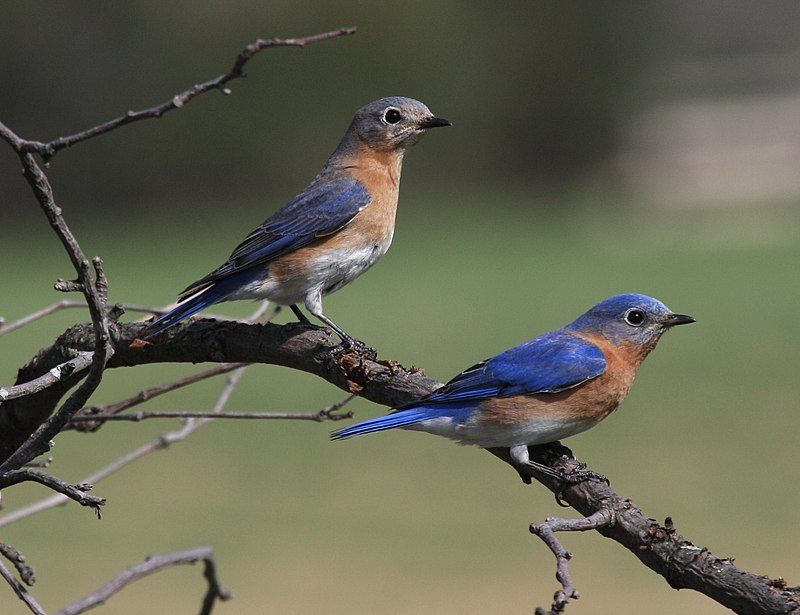
The eastern bluebird is a small migratory thrush found in North America. It inhabits a variety of habitats, such as open woodlands, farmlands, and orchards.
The male of the species has bright blue plumage that can easily be seen from a distance, making it a popular bird for birdwatchers. The bright colors of the male plumage help to attract potential mates during the breeding season.
The bluebird’s diet consists of mostly insects and berries found in the natural environment. It is an important species for maintaining a healthy ecological balance in the areas it occupies.
Birders often eagerly wait to observe the beautiful plumage of the male eastern bluebird, making it a favorite among birders.
| Kingdom | Animalia |
| Phylum | Chordata |
| Class | Aves |
| Order | Passeriformes |
| Family | Turdidae |
| Genus | Sialia |
| Species | S. Sialis |
2. Blue Jay

The blue jay is a species of bird from the Corvidae family, which is native to eastern North America. It is a highly adaptable bird and can be found in many areas of the eastern and central United States, as well as a small number of populations in Newfoundland, Canada.
In addition, there are breeding populations in southern Canada. The blue jay’s habitat is quite varied, ranging from forests and woodlands to urban areas. Its diet consists of a variety of foods such as fruits, nuts, insects, and small animals.
It is also known to cache food for later use. Blue jays have a distinctive blue crest and wings, which can be seen when they are foraging in the trees. Blue jays are intelligent birds with complex social behavior. They are social birds and form small flocks.
They can be quite vocal, making a variety of sounds including chattering and screeches. They also use their calls to communicate with other birds and can even imitate the sound of a hawk or owl. Migration patterns vary with some populations of blue jays being migratory.
This means that during the colder months, they will migrate to areas with milder climates. The migratory birds tend to return to their breeding grounds in the spring. Overall, the blue jay is a fascinating bird with interesting behaviors and habits.
It is an important part of the ecosystem, providing food for other animals and helping to spread seeds.
| Kingdom | Animalia |
| Phylum | Chordata |
| Class | Aves |
| Order | Passeriformes |
| Family | Corvidae |
| Genus | Cyanocitta |
| Species | C. cristata |
3. Indigo Bunting

The indigo bunting is a small bird that belongs to the cardinal family, Cardinalidae. It has a migratory habit, which means that it moves from one place to another in different seasons.
During the breeding season, the indigo bunting can be found in southern Canada and northern Florida. In the winter, it migrates to southern Florida and northern South America. It migrates mainly during the nighttime, using the stars as a guide.
This behavior is known as celestial navigation, which is a way of determining a bird’s position from the stars, the moon, and the sun. It is a very fascinating behavior that allows the bird to travel long distances with precision.
| Kingdom | Animalia |
| Phylum | Chordata |
| Class | Aves |
| Order | Passeriformes |
| Family | Cardinalidae |
| Genus | Passerina |
| Species | P. cyanea |
4. Barn Swallow

The barn swallow is a species of swallow that is found all over the world. It has a tremendously broad range, covering a total of 251 million square kilometers.
This makes it the most widespread passerine bird in the world – a passerine is a type of bird that perches on branches and wires. The barn swallow is also easily identifiable due to its blue upperparts and a long, deeply forked tail.
This vivid coloration is a striking contrast to its otherwise plain plumage. The long, forked tail is also a defining feature and is used by the barn swallow to navigate through the air while flying.
In addition, its long wingspan helps it to travel great distances when migrating. All these features make the barn swallow an impressive species of bird.
| Kingdom | Animalia |
| Phylum | Chordata |
| Class | Aves |
| Order | Passeriformes |
| Family | Hirundinidae |
| Genus | Hirundo |
| Species | H. rustica |
5. White-Breasted Nuthatch

The white-breasted nuthatch is a type of bird that belongs to the nuthatch family, known as Sittidae. It is a medium-sized bird, with a length of about 15.5 cm. The white-breasted nuthatch’s body is mainly gray in color, with white markings on the upper chest and face.
It has a black cap and a long, pointed bill. Its legs and feet are grayish-black.
The white-breasted nuthatch has a very distinctive call, which is often heard in the spring and summer months. The white-breasted nuthatch is a common species of bird, found in deciduous and coniferous forests throughout North America and parts of Central America.
They are usually seen in pairs or small groups, foraging for insects and other small invertebrates. They often feed on tree trunks and branches, clinging upside down to search for food.
They are also known to eat birdseed and suet from bird feeders. The white-breasted nuthatch is an important bird species for maintaining a healthy forest ecosystem. It feeds on insects that are harmful to trees, helping to protect them from damage.
They also serve as an important food source for other birds, such as woodpeckers and chickadees. In addition, their presence in an area may attract other species of birds, increasing the biodiversity of the forest.
| Kingdom | Animalia |
| Phylum | Chordata |
| Class | Aves |
| Order | Passeriformes |
| Family | Sittidae |
| Genus | Sitta |
| Species | S. carolinensis |
6. Red-Breasted Nuthatch

The red-breasted nuthatch is a small songbird with distinct features that make it stand out from other species. Its upperparts are a striking blue-grey, while its underparts are a warm cinnamon color.
Its face and throat are white with a black stripe running through its eyes, giving it an intense stare. Its bill is straight and grey, and its crown is black. Its call has been compared to a tin trumpet, as it is both high-pitched and nasal.
The red-breasted nuthatch is a unique and beautiful species that is sure to capture the attention of any bird watcher.
| Kingdom | Animalia |
| Phylum | Chordata |
| Class | Aves |
| Order | Passeriformes |
| Family | Sittidae |
| Genus | Sitta |
| Species | S. canadensis |
7. Tree Swallow
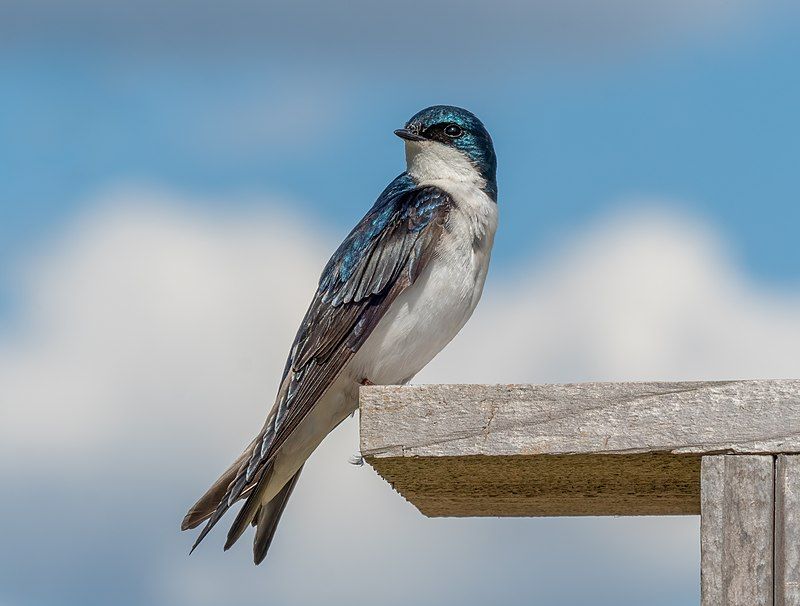
The tree swallow is a migratory bird that belongs to the family Hirundinidae. It is found mainly in the Americas and was first described by French ornithologist Louis Vieillot in 1807.
At the time, it was classified as Hirundo bicolor, but it has since been moved to the genus Tachycineta. Its exact phylogenetic placement within this genus is still debated among scientists.
The tree swallow is a small bird, typically measuring between 5-7 inches long and weighing around 0.5 ounces. It has a blue-black head, wings, and tail, with white patches on its throat and upper breast. Its bill is black and its legs are gray.
It is a fast flyer and is an agile hunter, feeding mainly on insects. Tree swallows migrate during the spring and fall, flying south for the winter and north for the summer. They are found in both open and wooded areas and typically build their nests in tree cavities.
They are social birds and can be seen flying and foraging in large flocks. The overall population of tree swallows is considered stable, although some local populations have seen a decline due to habitat destruction and the introduction of non-native species.
Conservation efforts are in place to protect this species and ensure its continued survival.
| Kingdom | Animalia |
| Phylum | Chordata |
| Class | Aves |
| Order | Passeriformes |
| Family | Hirundinidae |
| Genus | Tachycineta |
| Species | T. bicolor |
8. Common Grackle
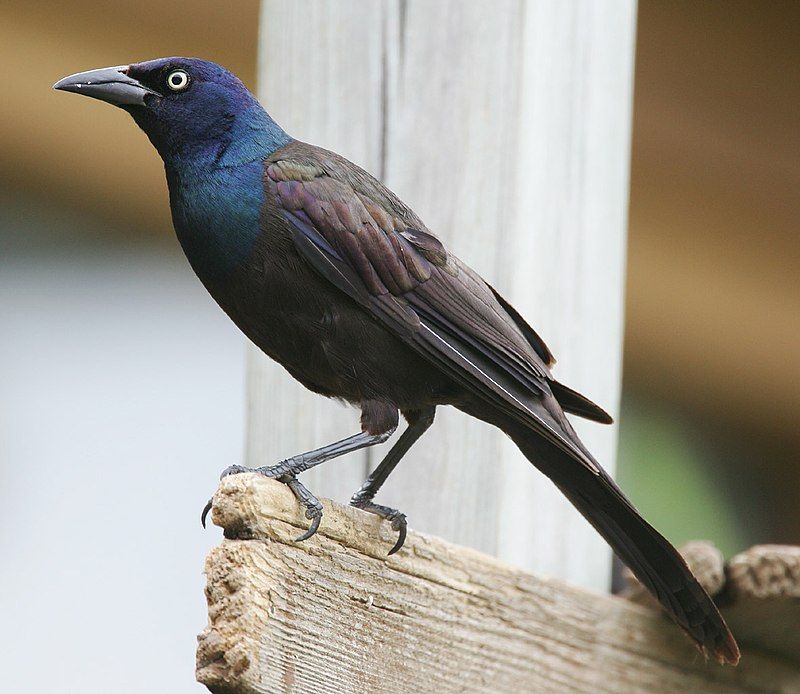
The Common Grackle is a species of large icterid bird found in large numbers throughout North America. It was first described in 1758 by the famous Swedish scientist Carl Linnaeus. The adult Common Grackle has a long and dark bill, pale yellow eyes, and a long tail.
The species is further divided into three subspecies, which differ in size and plumage color. The Common Grackle is a fairly large bird, measuring around 8 to 12 inches in length and weighing around 2.6 to 4.6 ounces.
They have a glossy black plumage with a bright iridescent green sheen and a distinctive yellow eye ring. The wings and tail are short and broad, and the tail is usually forked. The Common Grackle feeds mainly on insects, seeds, grain, and fruits.
During the winter months, they will also feed on human food scraps. They are very adaptable and can be found in a variety of habitats, including woodlands, wetlands, agricultural fields, and suburban areas. The Common Grackle is a social bird, often found in large flocks.
They are known to have a varied and complex vocal repertoire and are often heard singing in the early morning and late evening. They are also known to be quite aggressive when defending their territories.
The Common Grackle is an important species in North America, as they provide valuable pest control services to farmers and gardeners. They are also a popular subject for bird watching, due to their interesting behaviors and attractive plumage.
| Kingdom | Animalia |
| Phylum | Chordata |
| Class | Aves |
| Order | Passeriformes |
| Family | Icteridae |
| Genus | Quiscalus |
| Species | Q. quiscula |
9. Blue-Gray Gnatcatcher

The blue-gray gnatcatcher is a species of songbird found throughout North America. It is a small bird, measuring only about four inches in length with a wingspan of five to six inches. The bird has a pale blue-gray upper body, with a white underside and a black cap.
It also has a long, thin bill, which it uses to feed on small insects and spiders. It is a solitary bird, often seen foraging alone in dense thickets and vegetation.
The blue-gray gnatcatcher is a migratory species, with some populations wintering in southern states and some remaining in northern states year-round. It nests in dense shrubs and trees, laying two to four eggs at a time.
The blue-gray gnatcatcher is a valuable species to the North American ecosystem, as it helps control insect populations and is an important part of the food chain.
| Kingdom | Animalia |
| Phylum | Chordata |
| Class | Aves |
| Order | Passeriformes |
| Family | Polioptilidae |
| Genus | Polioptila |
| Species | P. caerulea |
10. Cerulean Warbler

The cerulean warbler is a small songbird that belongs to the family Parulidae. It is a long-distance migrant, which means that it travels far away during certain times of the year.
During the breeding season, it can be found in hardwood forests in the eastern part of North America. During the non-breeding season, it migrates to the eastern side of the Andes mountain range in South America, where it prefers subtropical forests.
The cerulean warbler is an important part of the ecosystem, providing many benefits to the environment, including pollination, pest control, and seed dispersal.
Its long-distance migration is essential for the survival of the species, as it allows the warbler to find food and shelter in different climates.
As a result, the cerulean warbler is an important contributor to the health of these habitats and a crucial part of the world’s biodiversity.
| Kingdom | Animalia |
| Phylum | Chordata |
| Class | Aves |
| Order | Passeriformes |
| Family | Parulidae |
| Genus | Setophaga |
| Species | S. cerulea |
11. Purple Martin

The purple martin is a species of bird belonging to the family Hirundinidae, which includes swallows. It is the largest swallow found in North America and is easily recognizable due to its large size and distinctively long, pointed wings.
Despite its name, the purple martin is not actually purple; its plumage is actually black or dark blue. Its head and neck are typically glossy blue-black, while its back and wings are a darker shade. The breast and belly of the bird are usually a lighter shade of gray.
The purple martin is a social bird that often forms large colonies and can often be seen nesting in colonies near human dwellings. It feeds on a variety of insects, making it a beneficial bird for farmers and gardeners alike.
| Kingdom | Animalia |
| Phylum | Chordata |
| Class | Aves |
| Order | Passeriformes |
| Family | Hirundinidae |
| Genus | Progne |
| Species | P. Subis |
12. New World Warblers

The New World warblers are a family of birds, often brightly colored, and are found only in the Americas. They belong to the family Parulidae and are not closely related to Old World warblers or Australian warblers, despite their similar names.
These birds are relatively small and, as their name suggests, they are passerines, meaning they are perching birds.
The New World warblers can be found all over the Americas, from the northernmost reaches of Alaska and Canada to the southernmost regions of Colombia and Venezuela. They inhabit a wide variety of habitats, including forests, shrublands, and even open grasslands.
New World warblers are also migratory, with many species traveling thousands of miles each year to winter in the warmer climates of Central and South America.
These birds are omnivores and feed on a wide variety of food, including insects, spiders, and other small invertebrates. They also eat fruits, berries, and seeds, as well as the occasional small lizard or amphibian.
The New World warblers are an important part of the food chain and play an important role in the ecology of the Americas. The New World warblers are a fascinating group of birds that are unique to the Americas.
They are brightly colored, adaptable, and provide a vital link in the food chain. They are an important part of the natural beauty of the Americas and serve as a reminder of the beauty and complexity of nature.
| Kingdom | Animalia |
| Phylum | Chordata |
| Class | Aves |
| Order | Passeriformes |
| Family | Parulidae |
13. Belted Kingfisher
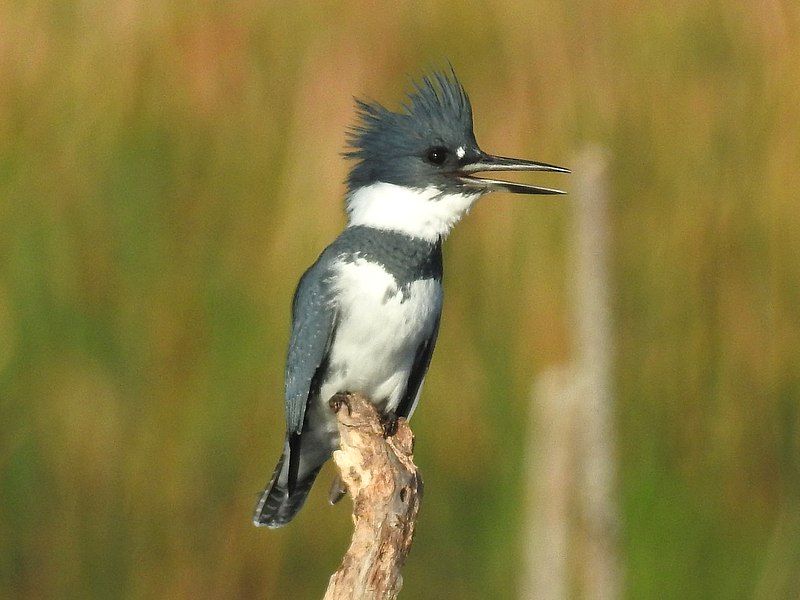
The belted kingfisher is a large, brightly colored bird that is native to North America. It belongs to the family Alcedinidae, which includes all varieties of kingfishers. Recent research has shown that this family should be divided into three separate subfamilies.
The belted kingfisher is one of the largest members of the family and is easily identifiable due to its distinctive size and color. It has a large head, a long, pointed bill, and a black-and-white striped head.
Its back is slate-blue, with a chestnut-colored band across the breast. It also has a white stripe on its wings, and its legs and feet are bright orange. The belted kingfisher is a strong flier and can be seen soaring above ponds and rivers, searching for its prey.
It mainly feeds on fish, frogs, and aquatic insects, which it catches by diving down from heights of up to 30 feet. It is often seen perched on branches or wires overlooking the water, ready to swoop down and catch its prey.
| Kingdom | Animalia |
| Phylum | Chordata |
| Class | Aves |
| Order | Coraciiformes |
| Family | Alcedinidae |
| Genus | Megaceryle |
| Species | M. alcyon |
14. Northern Parula
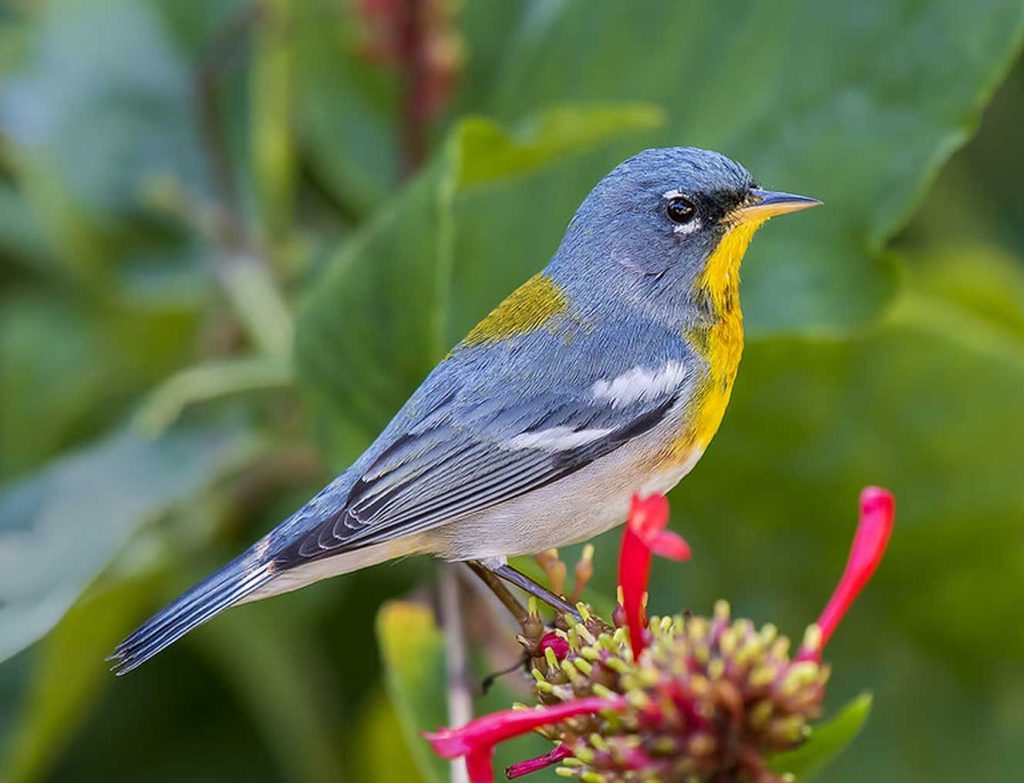
Source: dibird.com
The northern parula is a species of bird native to North America. It belongs to the family of New World warblers, which are noted for their brightly colored feathers.
The northern parula has a mainly blue-green upper body and yellowish-white underbelly, with darker blue-gray streaks on its wings and tail feathers. It can also be identified by its yellow throat and two white wing bars.
The northern parula breeds in eastern North America, from southern Canada all the way to Florida. Its range extends across the eastern United States, from the Great Lakes region down to the Gulf Coast. It can also be found in some parts of Mexico.
The northern parula typically breeds in deciduous and mixed forests, either in the lowlands or in the mountains. It prefers to build its nests in shrubs or small trees, near the ground. The northern parula typically feeds on insects, such as caterpillars, spiders, and beetles.
It also eats some berries and other fruit. During the non-breeding season, it migrates south toward Central America, South America, and the Caribbean.
The northern parula is an important species to the ecosystem, as it helps to control the population of insects that can damage crops and other plants. It is also a popular bird for birdwatchers, as it is easy to identify and is often found in large flocks.
| Kingdom | Animalia |
| Phylum | Chordata |
| Class | Aves |
| Order | Passeriformes |
| Family | Parulidae |
| Genus | Setophaga |
| Species | S. americana |
15. House finch

Source: reddit.com
The house finch is a species of bird in the finch family Fringillidae. It is native to western North America but has since been introduced to the eastern half of the continent and Hawaii.
This species is part of the genus Haemorhous, which is made up of two other species of American rosefinches. This genus is known for its brightly colored feathers, with males having a variety of red, pink, and orange plumage.
The house finch is a small, brown-streaked bird, with a large yellow bill and a bright red forehead. Its diet consists of seeds, fruits, and insects, and it is a very common backyard bird. It is also a popular pet bird and can be found in aviaries.
House finches are highly social, often seen in flocks, and can be heard singing throughout the day.
| Kingdom | Animalia |
| Phylum | Chordata |
| Class | Aves |
| Order | Passeriformes |
| Family | Fringillidae |
| Genus | Haemorhous |
| Species | H. mexicanus |
16. Common Starling

The common starling is a species of passerine bird that is widely distributed across the world. Also known as the European starling in North America and the starling in Great Britain and Ireland, this bird is a member of the Sturnidae family.
It is a medium-sized bird, which can range from 21 to 25 cm in length. It has a short tail and a wingspan of around 33 cm. The common starling has a glossy black plumage with iridescent green-brown, purple and blue hues. Its beak is yellow and its legs are orange.
It is a vocal bird and can be easily identified by its distinctive “cheep-cheep” call. The common starling is a very adaptable bird and can be found in a variety of habitats, including woodlands, grasslands, marshes, and urban areas.
It feeds mainly on insects and berries, but can also be seen scavenging for food in parks or on roadsides. It is an important part of many ecosystems and plays a crucial role in controlling insect populations.
| Kingdom | Animalia |
| Phylum | Chordata |
| Class | Aves |
| Order | Passeriformes |
| Family | Sturnidae |
| Genus | Sturnus |
| Species | S. vulgaris |
17. American Robin
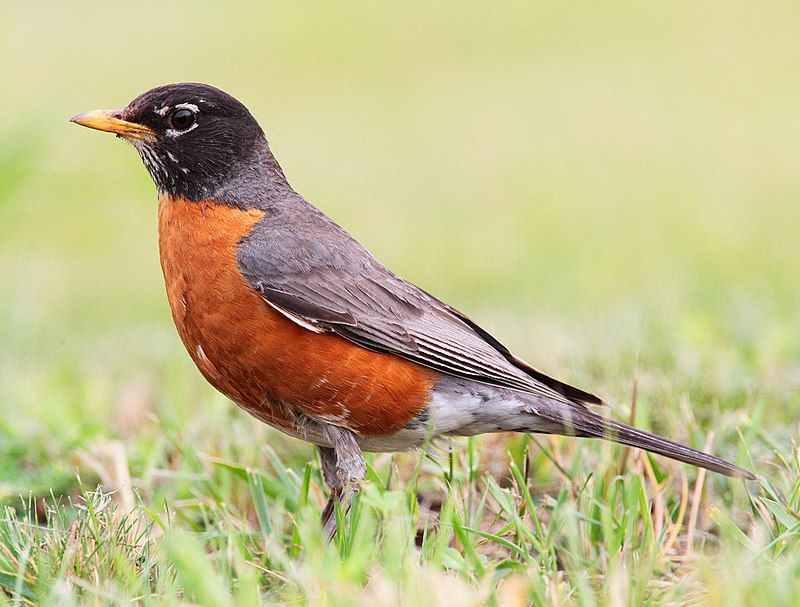
The American robin is a species of bird that belongs to the true thrush genus and the wider thrush family, Turdidae. It is called the American robin because of its striking reddish-orange breast, which is similar to the European robin.
Despite its shared name, the American robin is not closely related to the European robin. The European robin is part of the Old World flycatcher family, whereas the American robin is part of the true thrush family.
Migratory birds like the American robin travel from one place to another in search of food and suitable living conditions. This species of bird is popular due to its bright colors and melodious song, which can be heard in the early morning or in the late evening.
The American robin is a vital species for many ecosystems. It plays an important role in controlling insect populations, and its droppings are a source of nutrients for plants.
Additionally, the American robin is an important indicator species for environmental health and can indicate the presence of toxins in the environment.
| Kingdom | Animalia |
| Phylum | Chordata |
| Class | Aves |
| Order | Passeriformes |
| Family | Turdidae |
| Genus | Turdus |
| Species | T. migratorius |
18. Red-Winged Blackbird

Source: vtecostudies.org
The red-winged blackbird is a type of passerine bird found in North and Central America.
Passerines, also known as perching birds, are a large group of birds that have a distinctive arrangement of toes – three pointing forward and one pointing backward – which helps them grip onto branches and other surfaces.
Red-winged blackbirds are a species of the Icteridae family of birds, which includes many other species of blackbirds found in the Americas.
They can be found in most of North America and much of Central America, including Mexico, Belize, Guatemala, El Salvador, Honduras, Nicaragua, Costa Rica, and Panama.
Red-winged blackbirds are known for their distinctive black and yellow-orange plumage, which is easily recognizable in the wild. They can be found in a variety of habitats, including grasslands, wetlands, and woodlands, and are usually found near water.
They are omnivorous, meaning that they feed on both plants and animals. They have a varied diet, consisting of insects, grains, fruits, and even small vertebrates.
Red-winged blackbirds are also known for their beautiful songs, which they use to attract mates and defend their territories.
| Kingdom | Animalia |
| Phylum | Chordata |
| Class | Aves |
| Order | Passeriformes |
| Family | Icteridae |
| Genus | Agelaius |
| Species | A. phoeniceus |
19. Brown-Headed Cowbird

Source: ebird.org
The brown-headed cowbird is a small, blackbird-like species of bird found in temperate and subtropical North America. This species is an obligate brood parasite, which means that it lays its eggs in the nests of other bird species instead of building its own nest.
In the southern parts of its range, the brown-headed cowbird is a permanent resident, while birds in the northern parts migrate southward to the United States and Mexico during the winter months. These birds typically return to their summer habitat from March to April.
Brown-headed cowbirds are known to be very aggressive when it comes to finding suitable nesting sites. They will often seek out the nests of smaller birds, such as warblers and sparrows, and lay their eggs in them.
The young cowbird chicks are then raised by the host bird, which can be detrimental to the host’s own offspring. Brown-headed cowbirds are also thought to contribute to the decline of some North American songbird species.
| Kingdom | Animalia |
| Phylum | Chordata |
| Class | Aves |
| Order | Passeriformes |
| Family | Icteridae |
| Genus | Molothrus |
| Species | M. ater |
20. Gray Catbird
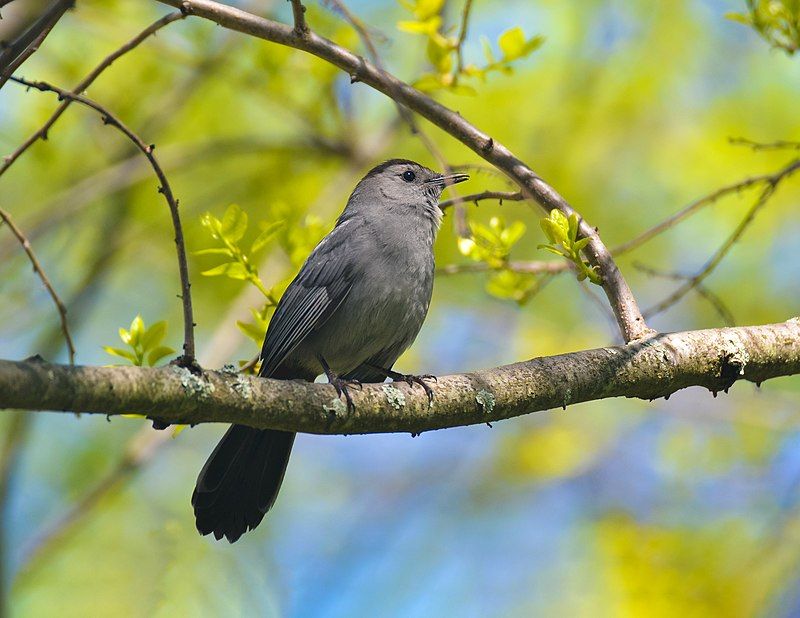
The Gray Catbird (also spelled Grey Catbird) is a species of bird found in North America and Central America. It is a member of the Mimidae family, which includes thrashers, mockingbirds, and New World catbirds.
This bird is distinguished by its grayish-brown plumage and its long tail, which is tipped with black.
It is the only species in the genus Dumetella, which is derived from the Latin for ‘small bush’.The Gray Catbird is a medium-sized bird, typically measuring between 7 and 9 inches in length. It has a grayish-brown back and wings, and a white underside.
The head and neck are black, while the breast and belly are a lighter shade of gray. Its tail is long and black-tipped.
It has a sharp, raspy call, which is often used as a warning against potential predators. The Gray Catbird is mostly found in deciduous and mixed forests, as well as urban and suburban areas. It feeds on a variety of fruits, nuts, and insects.
Nests are typically built in shrubs and trees and can be lined with grass, leaves, and feathers. The female lays 3-5 eggs, which are incubated for 12-14 days. The Gray Catbird is an important species for both conservation and research.
It is a keystone species in its habitat, and its presence can indicate a healthy and diverse ecosystem. As such, its population should be closely monitored to ensure its continued survival.
| Kingdom | Animalia |
| Phylum | Chordata |
| Class | Aves |
| Order | Passeriformes |
| Family | Mimidae |
| Genus | Dumetella |
| Species | D. carolinensis |
21. Tufted Titmouse

The tufted titmouse is a small songbird native to North America. It is a member of the tit and chickadee family and is easily recognizable by its grey body, white cheeks, and a black tuft of feathers on the top of its head.
The tufted titmouse is found mainly in the Eastern half of the United States, though it can also be found in the Midwest and South. The black-crested titmouse is a close relative of the tufted titmouse and was originally thought to be a subspecies of the tufted titmouse.
However, further research has determined that it is a separate species, Baeolophus atricristatus. The black-crested titmouse is found primarily in central and southern Texas, though it may be found in other areas of the South as well.
Both the tufted titmouse and the black-crested titmouse are important species to the local environment, as they are important pollinators and seed dispersers. They are also a popular bird for bird-watchers, as they are very active and often seen in flocks.
| Kingdom | Animalia |
| Phylum | Chordata |
| Class | Aves |
| Order | Passeriformes |
| Family | Paridae |
| Genus | Baeolophus |
| Species | B. bicolor |
22. Cliff swallow
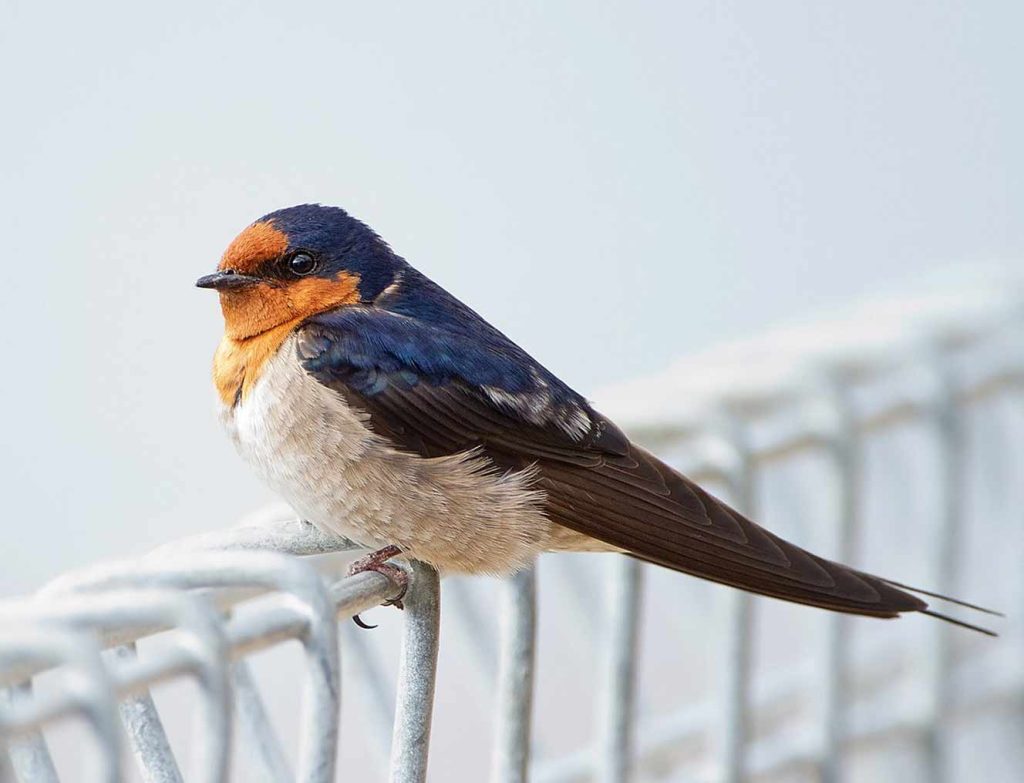
Source: wikipedia.org
The cliff swallow, also known as the American cliff swallow, is a small, migratory bird that belongs to the Hirundinidae family, commonly referred to as the swallows and martins.
This species of swallow is found throughout North, Central, and South America, and they typically inhabit areas near cliffs or other tall structures such as bridges and buildings.
They are distinguished by their small size, dark grayish-brown upperparts, and lighter brownish-gray underparts. They have long, forked tails and a pale rufous throat and forehead.
During the breeding season, they form large colonies and build their cup-shaped mud nests on the vertical walls of cliffs and other structures. The cliff swallow is an insectivorous bird that feeds primarily on flying insects.
They fly and feed in flocks, and they are known to migrate over long distances in search of food resources during the non-breeding season.
| Kingdom | Animalia |
| Phylum | Chordata |
| Class | Aves |
| Order | Passeriformes |
| Family | Hirundinidae |
| Genus | Petrochelidon |
| Species | P. pyrrhonota |
23. Little Blue Heron

The little blue heron is a small bird that belongs to the genus Egretta. It is a darkish heron that has a two-toned beak. Juveniles are entirely white, making them resemble the snowy egret.
During the breeding season, adult little blue herons develop different colors on their head, legs, and feet. This is a way of attracting mates and distinguishing themselves from other herons.
The head, legs, and feet will usually turn a rusty brown color, while their neck and back feathers may become gray-blue. This helps them stand out in their environment and displays their vibrant beauty.
The little blue heron is a unique and remarkable species that is easily recognizable because of its distinct coloration.
| Kingdom | Animalia |
| Phylum | Chordata |
| Class | Aves |
| Order | Pelecaniformes |
| Family | Ardeidae |
| Genus | Egretta |
| Species | E. caerulea |
24. Painted Bunting

The painted bunting is a colorful species of bird that belongs to the cardinal family, Cardinalidae. It is native to North America and can be found in places such as woodlands, parks, and gardens.
The male of the species has a particularly vibrant plumage, however, this only appears in its second year of life. Before this point, they can only be identified from the female of the species through careful observation.
The females are much less colorful, being mostly gray and olive in color. During the breeding season, males often form flocks to attract females and protect their territories.
The painted bunting is a popular bird with bird watchers, as its bright plumage can be seen from a distance.
| Kingdom | Animalia |
| Phylum | Chordata |
| Class | Aves |
| Order | Passeriformes |
| Family | Cardinalidae |
| Genus | Passerina |
| Species | P. Ciris |
25. Lesser Goldfinch
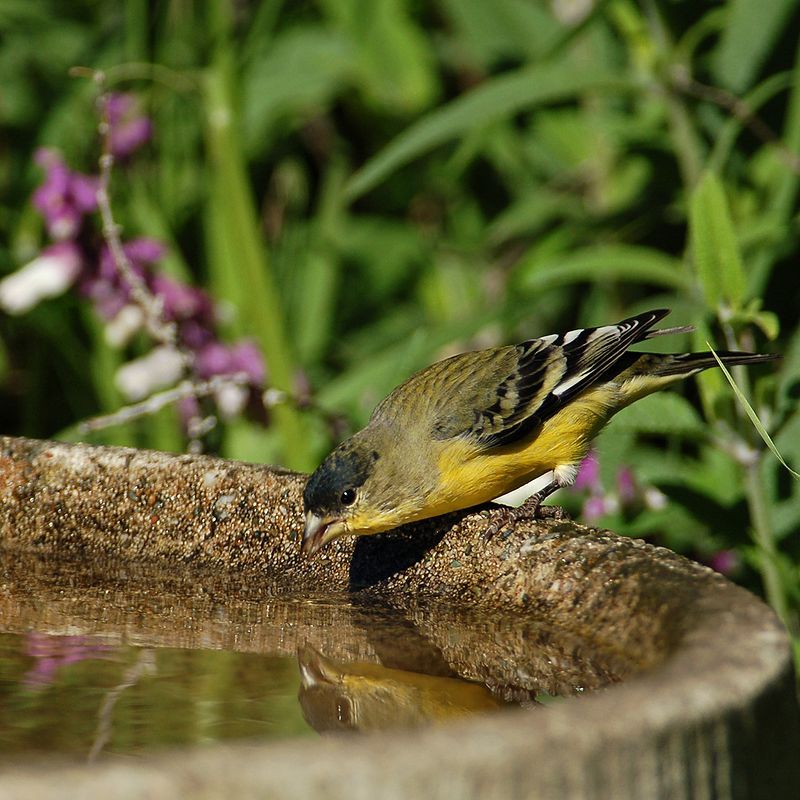
The lesser goldfinch is a small, songbird native to the Americas. It belongs to the New World goldfinch clade of the genus Spinus, which also includes the American goldfinch and Lawrence’s goldfinch.
Males of all three New World goldfinches have a black forehead, while females do not possess this trait. This black forehead is often used to differentiate between the male and female lesser goldfinch.
It is an important feature of the species, along with the distinct yellow coloring of the feathers. The lesser goldfinch is also known for its unique song, which is composed of various whistles and trills.
The lesser goldfinch is found in a variety of habitats, including open woodlands, grasslands, and wetlands. They are often found in small flocks, and they feed on seeds, insects, and fruits.
In addition to their unique appearance and song, the lesser goldfinch is also known for its acrobatic flight, which often involves hovering and twirling.
Overall, the lesser goldfinch is an interesting and unique species of songbird, and it is important to recognize its distinctive traits.
Its black forehead and yellow feathers make it easily identifiable, and its interesting song and acrobatic flight make it a pleasure to observe.
| Kingdom | Animalia |
| Phylum | Chordata |
| Class | Aves |
| Order | Passeriformes |
| Family | Fringillidae |
| Genus | Spinus |
| Species | S. psaltria |
Conclusion:
Blue birds are an important part of Iowa’s natural landscape. They are easily visible and can be found in many parts of the state. Blue birds provide an important source of food for other birds and wildlife, and they also help to keep insect populations in check.
As long as their habitats remain protected, blue birds will continue to be a vital part of the Iowa ecosystem for many years to come.